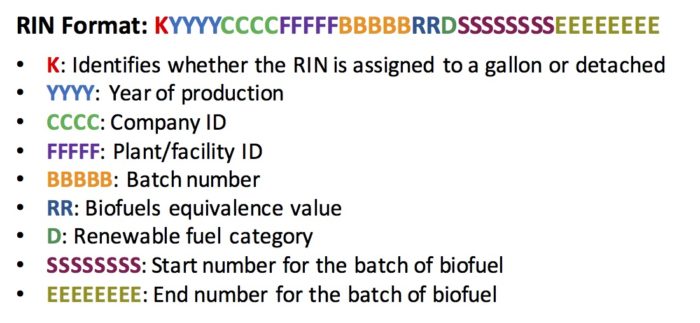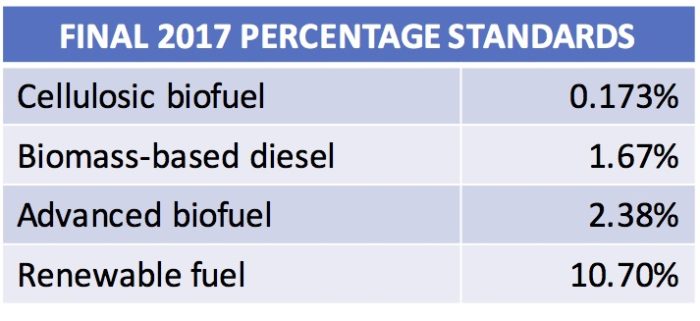The RFS Point of Obligation Part 2: How are RINs generated and RFS compliance achieved?
Link to article: https://stillwaterassociates.com/rfs-point-obligation-part-2-rins-generated-rfs-compliance-achieved/
June 6, 2017
by Michael Leister
Last month in the first edition in our RFS Point of Obligation series, we discussed the general RFS rules, this month we get more specific about RIN generation and RFS Compliance. When a renewable fuel producer like an ethanol production facility or biomass-based diesel manufacturing plant produces a compliant renewable fuel, the renewable fuel producer registers the renewable fuel batch with the EPA through the Moderated Transaction System (EMTS). EMTS then creates the RINs associated with each gallon of that batch. Each RIN is a 38-digit number represented by the format below:

RINs start out attached to the physical gallon of renewable fuel. In the case of corn ethanol, the D6 RINs remain attached until the ethanol is blended with gasoline or until an obligated party acquires the batch or a portion of the batch. D6 RINs are generated on a one to one basis for each gallon of ethanol. An obligated party or an ethanol blender can separate the D6 RINs from the physical gallons of ethanol. These separated RINs can be kept for compliance or they can be bought, sold or transferred. RINs may be used for compliance in the year they are generated or the following year.
Biomass-based diesel (BBD) RINs are handled in a similar manner with the exception that the D4 BBD RINs can be separated immediately out of the production facility if the BBD is sold as 99% BBD. BBD has an equivalence value of 1.5 D4 RINs per gallon of BBD based on having a higher energy content than ethanol. Renewable diesel has an equivalence factor of 1.7, so 1.7 D4 RINs are generated in EMTS for each gallon of renewable diesel.
Each year EPA publishes the percentage requirements for obligated parties to demonstrate compliance. For 2017, the percentage requirements are as indicated in table below:

By the compliance date for 2017, obligated parties will need to calculate their Renewable Volume Obligation (RVO), in each of these four categories by multiplying the percentage by their gasoline and diesel production for 2017. For example, an obligated party with 100,000 gallons of gasoline production and 50,000 gallons of diesel production would have an obligation for 2,505 D4 or D7 RINS (150,000 times 0.0167). Similarly, the cellulosic RVO would be 260 cellulosic D3 or D7 RINs, the advanced biofuel RVO would be 3,570 advanced D3, D4, D5 or D7 RINs, and the renewable fuel RVO would be 16,050 renewable or any other higher (D3, D4, D5, D6 or D7) RINs.
Obligated parties would have until March 31, 2018 to demonstrate compliance with the 2017 RVOs. At the time of compliance, RINs used for compliance are retired in EMTS.
Tags: Renewable Fuels Standard, RFSCategories: News, Policy, White Papers
